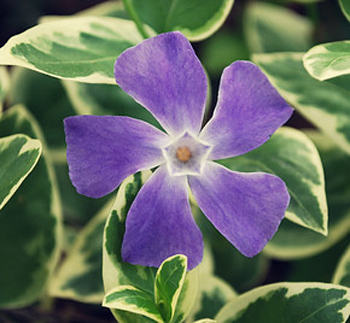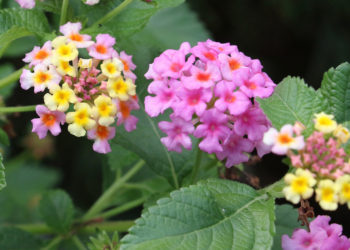Vinca, also known as periwinkle (a much cuter and more illustrative name), is a beautiful, fast-growing, prolific plant from the family Apocynaceae, or Dogbane. This drought-tolerant annual is perfect for hot, dry planting areas in need of some gorgeous bursts of color.
A Vine with Many Species
Vinca vine has six different species. The flowers are usually blue or bluish purple and are solitary, and funnel-shaped. You’ll find them in 43 of the 50 United States. They’re native to North America (that’s the U.S. and Canada), as well as Europe, China and India. Vincas are hardy and not often plagued by bugs or illness, making them a low maintenance, beautiful ground cover.
Vinca major and Vinca minor, two of the six Vinca species, are extensively cultivated as a flowering evergreen ornamental plant, but they are also sometimes considered invasive species and weeds. Because the plants are low-growing and spread quickly, they are often used as a ground cover in garden landscapes and container gardens.
How to Care for Vinca
Vinca’s shiny, glossy green leaves really enhance its beauty. The flowers bloom from seeds from late spring to early summer in moist, well-drained soil. But you’ll find that these vines tolerate soil that may even be poor and dry. Vinca fares well in part shade to shade. And will tolerate a northern sun if they’re given sufficient moisture. Space plants 12 to 15 inches apart. Water well when planting, and after, only water during extended droughts. They’ll grow one to two feet tall. Use a general fertilizer only once or twice a season. Mulch around dry areas to keep the soil moist.

Using it in Garden Design
This vine is popular with landscapers. They use it in their designs for everything from cascading from containers, in woodland gardens, on slopes for erosion control and as vigorous aggressive ground cover. Bear in mind that Vinca spreads quickly, so it isn’t an ideal choice for areas where containment may be an issue.
Ready to add some Vinca to your garden? Check out our selection and get growing!





2 Comments
Sue S.
April 29, 2011 at 1:16 pmI read your blog about vinca vines with great interest. I have a few patches that are 10 years old and beginning to look leggy or empty in the center and do not flower very much. How can I get these plants back into shape? I do fertilize and try to rake the debris from them each spring to remove the dead leaves and shoots. Also if I cut off the empty runners, will they sprout roots and eventially turn into a plant?
Thanks for your help.
Karen
April 29, 2011 at 1:17 pmSue,
There are a couple of vines used as groundcover that are both commonly called vinca, and sadly they are very similar looking. Vinca major, referred to in the blog, and the similar-looking Wintercreeper, are often confused. Vinca is a member of the Apocynaceae family, and Wintercreeper is a member of the Euonymus family. Wintercreeper is a woody, perennial vine with small greenish clusters of flowers on long flower stalks producing round fruits maturing to an orangish color in June and July. These long, woody vines can reach more than 20 feet. The leaves are always dark green with prominent veins. Vinca major, the ground cover type, has a similarly shaped leaf but is usually a brighter green color. Its stems are also more slender and can root easily where they touch. The blooms that appear in the spring are the typical periwinkle blue color.
The varieties we feature on our site are normally used as pot fillers to serve as the “spiller” aspect of the “thriller, filler and spiller” rule of pot arrangement. You will see that ours offer some unusual leaf variegation and coloring to really add interest to your containers.
As to your question of revitalizing your ten-year-old groundcover, my suggestion might sound a bit harsh. Whether you have Wintercreeper or Vinca, both are considered invasive. However, both can be handled with a fairly heavy hand to keep them in line and neither require any fertilization. If you have Wintercreeper with the heavier stems, you can run over it with a mower and force it to produce new growth. You can take cuttings to help fill in areas that have died out. If you have Vinca, you can still cut it way back to encourage new growth but I would use a string trimmer or a hedge trimmer to do it. Wintercreeper is especially aggressive, capable of growing over rocks and completely eliminating native groundcovers and spring ephemerals, and even can degrade natural forests.
Good luck with your groundcover and try some of our pretty, and less troublesome, varieties in some of your summer pot arrangements.
Happy gardening,
Karen